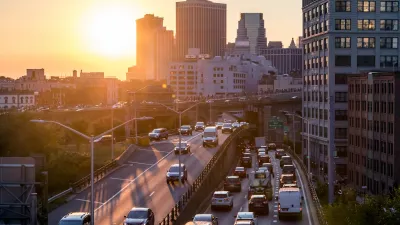The Texas Transportation Institute (TTI) released its 2011 Urban Mobility Report, which shows how many additional hours in traffic each commuter would be subject to if public transportation were discontinued.
The TTI focused on several aspects when doing their study. When looking into the value of transit, they found that "New York is far and away the winner with 63 hours of additional delay per peak period auto commuter if its transit system were discontinued," writes Aaron M. Renn.
The TTI report also calculates the additional congestion cost that would occur if public transit suddenly stopped, charted by Renn as the current savings that cities get by having transit:
"New York dominates the charts with nearly $8 billion in savings. But even down the charts there's big money. In Chicago, which is gearing up for another round of fare hikes and service cuts, the cost of congestion avoided due to public transit is about the same as the combined operating budget of all regional transit agencies. Chicago transit is effectively self-funded in terms of benefits delivered to motorists alone," says Renn.
FULL STORY: The Cost Of Congestion, The Value Of Transit

Planetizen Federal Action Tracker
A weekly monitor of how Trump’s orders and actions are impacting planners and planning in America.

Map: Where Senate Republicans Want to Sell Your Public Lands
For public land advocates, the Senate Republicans’ proposal to sell millions of acres of public land in the West is “the biggest fight of their careers.”

Restaurant Patios Were a Pandemic Win — Why Were They so Hard to Keep?
Social distancing requirements and changes in travel patterns prompted cities to pilot new uses for street and sidewalk space. Then it got complicated.

Platform Pilsner: Vancouver Transit Agency Releases... a Beer?
TransLink will receive a portion of every sale of the four-pack.

Toronto Weighs Cheaper Transit, Parking Hikes for Major Events
Special event rates would take effect during large festivals, sports games and concerts to ‘discourage driving, manage congestion and free up space for transit.”

Berlin to Consider Car-Free Zone Larger Than Manhattan
The area bound by the 22-mile Ringbahn would still allow 12 uses of a private automobile per year per person, and several other exemptions.
Urban Design for Planners 1: Software Tools
This six-course series explores essential urban design concepts using open source software and equips planners with the tools they need to participate fully in the urban design process.
Planning for Universal Design
Learn the tools for implementing Universal Design in planning regulations.
Heyer Gruel & Associates PA
JM Goldson LLC
Custer County Colorado
City of Camden Redevelopment Agency
City of Astoria
Transportation Research & Education Center (TREC) at Portland State University
Camden Redevelopment Agency
City of Claremont
Municipality of Princeton (NJ)





























